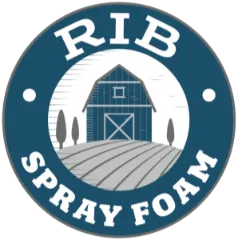Spray foam insulation creates an air seal that reduces thermal leakage, significantly lowering energy bills and improving indoor comfort. The insulation expands upon application, filling gaps, cracks, and cavities more effectively than traditional materials. This minimizes air exchange between indoor and outdoor environments, which means HVAC systems require less effort to maintain a consistent temperature.
By preventing heat transfer and controlling humidity infiltration, spray foam insulation keeps interior spaces warmer during winter and cooler in summer. The result is a more stable indoor environment with fewer temperature swings and reduced strain on heating and cooling systems. Rib Spray Foam Company applies proven techniques and hands-on expertise to ensure proper installation that maximizes energy efficiency.
How Spray Foam Insulation Works
Spray foam insulation uses a two-part chemical mixture that reacts and expands rapidly to form a rigid, sealed barrier. This barrier adheres tightly to surfaces, including studs, pipes, and wires. Closed-cell spray foam, in particular, offers a higher R-value per inch compared to other insulation types, creating both an insulating layer and a moisture barrier.
Technical Performance Comparison
| Insulation Type | R-Value per Inch | Air Sealing Capability | Moisture Resistance | Structural Strength |
|---|---|---|---|---|
| Closed Cell Spray Foam | 6.0 – 7.5 | Excellent | High | High |
| Open Cell Spray Foam | 3.5 – 4.0 | Good | Moderate | Low |
| Fiberglass Batts | 2.9 – 3.8 | Poor | Low | None |
| Cellulose | 3.2 – 3.8 | Moderate | Low | None |
Bonus Tip
In northern Colorado’s mixed climate, where both heating and cooling are critical, closed cell spray foam provides an effective all-season solution due to its high R-value and vapor barrier properties.
Measurable Impact on Energy Consumption
According to data from the U.S. Department of Energy, up to 40% of energy loss in buildings occurs due to air infiltration. Spray foam insulation directly reduces this loss by forming a continuous seal across building envelopes.
Studies from Oak Ridge National Laboratory show buildings with closed cell spray foam can reduce energy use for heating and cooling by 20-50% depending on structure age and climate zone.
| Efficiency Metric | Typical Reduction with Spray Foam |
|---|---|
| Annual HVAC Energy Usage | 20% – 50% |
| Indoor Temperature Fluctuation | 60% Reduction |
| Drafts and Cold Spots | Near Elimination |
| Humidity Infiltration | Significantly Lower |

Bonus Tip
Installers should target all thermal bypass areas, including rim joists, attic slopes, and crawl space walls. Overlooking these zones leads to diminished results despite partial insulation.
Comfort Gains Beyond Energy Savings
Spray foam insulation enhances comfort by regulating indoor air quality, reducing noise transmission, and maintaining uniform room temperatures. Closed cell foam’s dense structure acts as a sound dampener while limiting allergen entry by sealing exterior air paths.
Condensation control in crawl spaces and attics lowers the chance of mold or mildew growth, particularly in humid areas or older homes.
Bonus Tip
In retrofits, crawl space spray foam offers the most noticeable comfort improvement in homes with drafty floors or musty odors.
Practical Considerations Before Choosing Insulation
- Building Type: New construction allows full-envelope application; existing homes may require targeted retrofitting.
- Climate Zone: Closed cell foam suits areas with large temperature swings, such as Colorado’s Front Range.
- Moisture Exposure: Basements, crawl spaces, and pole barns benefit most from closed cell foam’s moisture resistance.
- Access Points: Professional installers must inspect framing and utility penetrations to ensure proper coverage.
Rib Spray Foam Company Provides Specialized Solutions
The following services address the most impactful insulation areas:
- Closed Cell Spray Foam: High-density foam with superior R-value and vapor barrier capabilities.
- Crawl Space Spray Foam: Controls moisture and heat loss under floors.
- Pole Barn Spray Foam: Adds structure and climate control to unconditioned outbuildings.
- New Construction Spray Foam: Full-envelope application during framing stage for best performance.
Questions to Ask Before Making a Choice
How long does installation take?
Most jobs complete within 1–2 days depending on size and access.
Will spray foam damage wiring or plumbing?
No. It conforms around fixtures without causing pressure damage.
Can it be installed in winter?
Yes. Proper equipment allows for consistent application even in cold temperatures.
Is ventilation needed after install?
Yes. A short off-gassing period of 12–24 hours is typical. Spaces should remain unoccupied during that window.
Make a Confident Decision Backed by Experience
Spray foam insulation delivers measurable improvements in energy efficiency and occupant comfort. Results depend on material type, application quality, and the building’s characteristics. Evaluate your structure’s needs and climate conditions to determine the most effective approach.
Get Expert Help From Rib Spray Foam Company
Rib Spray Foam Company applies proven insulation techniques based on real-world building performance. For service inquiries or expert guidance, contact [email protected] or call (970) 518-2883.
Long-Term Questions After Installation
How long does spray foam insulation last?
Properly installed spray foam can last the lifetime of the structure without degradation.
What maintenance is required?
None. Occasional inspections are recommended to ensure structural access hasn’t compromised coverage.
Can pests damage spray foam?
Spray foam does not attract rodents or insects and forms a barrier that helps keep them out.
Is spray foam environmentally safe?
Once cured, it is inert. Many modern formulations have low global warming potential (GWP) blowing agents.
Does it prevent ice dams?
By reducing heat loss through roof decking, it minimizes the conditions that cause ice dam formation.



